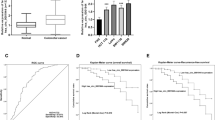Abstract
Background and aims
Formin-like 2 (FMNL2) is a member of diaphanous-related formins which can control the actin-dependent processes such as cell motility and invasion. In this study, we investigated the expression of FMNL2 in colorectal cancer (CRC) and its correlation with CRC metastasis.
Patients–methods
Paraffin-embedded specimens of CRC (including 75 primary CRC tumors and 45 corresponding metastatic lymph nodes) and normal colorectal mucosa (30 samples) were immunostained with a FMNL2 antibody. Thirty-two paired snap-frozen tumor tissues and adjacent normal colorectal mucosa were subjected to real-time reverse-transcription polymerase chain reaction (RT-PCR). Six CRC cell lines (SW480, SW620, SW480/M5, LoVo, LS174T, and HT29) were assayed for FMNL2 expression by Western blotting and real-time RT-PCR. Their invasive abilities in vitro were determined by Boyden chamber assay.
Results
The immunohistochemical analysis showed FMNL2 expression was considerably higher in CRC tumors and corresponding metastatic lymph nodes than in normal colorectal mucosa (P < 0.05, respectively). Elevated FMNL2 expression was significantly correlated with lymphatic metastasis of CRC (P < 0.05). Real-time RT-PCR analysis confirmed the results obtained by immunohistochemistry. At mRNA and protein levels, FMNL2 expression was substantially upregulated in cell lines derived from CRC metastases (SW620, SW480/M5, and LoVo) compared to ones derived from primary CRC (HT29, LS174T, and SW480; P < 0.05). In vitro cell invasive assay demonstrated that the former three cell lines had higher invasive ability than the latter cell lines.
Conclusions
FMNL2 may play an important role in the metastasis of CRC and may be a useful marker for metastasis of CRC.





Similar content being viewed by others
Abbreviations
- FMNL2:
-
formin-like 2
- CRC:
-
colorectal cancer
- IHC:
-
immunohistochemistry
- DRFs:
-
diaphanous-related formins
References
Jemal A, Murray T (2005) Ward ECancer statistics. CA Cancer J Clin 55:10–30
Millikan KW, Staren ED, Doolas A (1997) Invasive therapy of metastatic colorectal cancer to the liver. Surg Clin North Am 77:27–48
Zhang YF, Liu L, Ding YQ (2007) Isolation and characterization of human colorectal cancer cell subline with unique metastatic potential in the liver. Nan Fang Yi Ke Da Xue Xue Bao 27:126–130
Goode BL, Eck MJ (2007) Mechanism and function of formins in the control of actin assembly. Annu Rev Biochem 76:593–627
Higgs HN (2005) Formin proteins: a domain-based approach. Trends Biochem Sci 30:342–353
Faix J, Grosse R (2006) Staying in shape with formins. Dev Cell 10:693–706
Eisenmann KM, Harris ES, Kitchen SM, Holman HA, Higgs HN, Alberts AS (2007) Dia-interacting protein modulates formin-mediated actin assembly at the cell cortex. Curr Biol 17:579–591
Sahai E (2005) Mechanisms of cancer cell invasion. Curr Opin Genet Dev 15:87–96
Wodarz A, Näthke I (2007) Cell polarity in development and cancer. Nat Cell Biol 9:1016–1024
Vasiliev JM (2004) Cytoskeletal mechanisms responsible for invasive migration of neoplastic cells. Int J Dev Biol 48:425–439
Watanabe N, Madaule P, Reid T, Ishizaki T, Watanabe G, Kakizuka A, Saito Y, Nakao K, Jockusch BM, Narumiya S (1997) p140mDia, mammalian homolog of Drosophila diaphanous, is a target protein for Rho small GTPase and is a ligand for profilin. EMBO J 16:3044–3056
Kitzing TM, Sahadevan AS, Brandt DT, Knieling H, Hannemann S, Fackler OT, Grosshans J, Grosse R (2007) Positive feedback between Dia1, LARG, and RhoA regulates cell morphology and invasion. Genes Dev 21:1478–1483
Soumaoro LT, Uetake H, Higuchi T, Takagi Y, Enomoto M, Sugihara K (2004) Cyclooxygenase-2 expression: a significant prognostic indicator for patients with colorectal cancer. Clin Cancer Res 10:8465–8471
Livak KJ, Schmittgen TD (2001) Analysis of relative gene expression data using real time quantitative PCR and the 2-Delta Delta CT Method. Methods 25:402–408
Itoh F, Yamamoto H, Hinoda Y, Imai K (1996) Enhanced secretion and activation of matrilysin during malignant conversion of human colorectal epithelium and its relationship with invasive potential of colon cancer cells. Cancer 77:1717–1721
Mlodzik M (2002) Planar cell polarization: do the same mechanisms regulate Drosophila tissue polarity and vertebrate gastrulation? Trends Genet 18:564–571
Pellegrin S, Mellor H (2005) The Rho family GTPase Rif induces filopodia through mDia2. Curr Biol 15:129–133
Katoh M, Katoh M (2003) Identification and characterization of human FMNL1, FMNL2 and FMNL3 genes in silico. Int J Oncol 22:1161–1168
Rivero F, Muramoto T, Meyer AK, Urushihara H, Uyeda TQ, Kitayama C (2005) A comparative sequence analysis reveals a common GBD/FH3-FH1-FH2-DAD architecture in formins from Dictyostelium, fungi and metazoa. BMC Genomics 6:28
Alberts AS (2001) Identification of a carboxyl-terminal diaphanous-related formin homology protein autoregulatory domain. J Biol Chem 276:2824–2830
Rose R, Weyand M, Lammers M, Ishizaki T, Ahmadian MR, Wittinghofer A (2005) Structural and mechanistic insights into the interaction between Rho and mammalian Dia. Nature 435:513–518
Acknowledgments
This work was supported by the National Natural Science Foundation of China Nos. 30400206, 30370649, 30670967, and 30770977.
Author information
Authors and Affiliations
Corresponding author
Rights and permissions
About this article
Cite this article
Zhu, XL., Liang, L. & Ding, YQ. Overexpression of FMNL2 is closely related to metastasis of colorectal cancer. Int J Colorectal Dis 23, 1041–1047 (2008). https://doi.org/10.1007/s00384-008-0520-2
Accepted:
Published:
Issue Date:
DOI: https://doi.org/10.1007/s00384-008-0520-2




